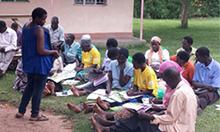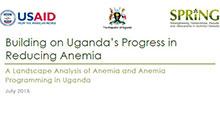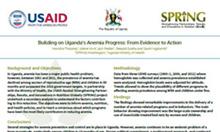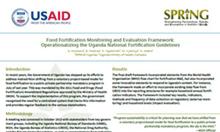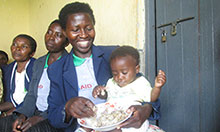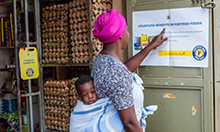Executive Summary

Background
Malnutrition among adolescents can adversely affect health and productivity in adult life; among school-going children, micronutrient deficiencies such as iron-deficiency anemia can reduce overall learning ability and concentration. Improving the nutritional quality of meals served to school-age children has the potential to reduce the severity of stunting and anemia and to support cognitive function. Uganda’s Ministry of Education and Sports 2013 guidelines recommend increased consumption of diverse nutritious foods, including fortified foods. The SPRING project in Uganda examined the barriers to and enablers of procurement and use of fortified maize flour in boarding schools in Uganda as a method of increasing micronutrient intake and overcoming widespread iron deficiency.
Methods
SPRING/Uganda conducted mixed-methods research between August and October of 2017 in four sub-regions of Uganda (Acholi, West Nile, Busoga, and Greater Kampala). This research included six focus group discussions (FGDs) with head teachers and school administrators of selected secondary boarding schools and four FGDs with maize millers in the same sub-regions. We distributed 24-hour recall surveys for maize-based foods to 216 students ages 12 to 19 years and 7-day surveys on consumption of essential food groups to 193 different students in the selected schools. We conducted organoleptic assessment tests of prepared fortified foods and unfortified foods with 216 students. Participants rated general appearance, color, taste, aroma, mouthfeel, aftertaste, thickness/texture, and overall acceptability of the four samples using a 9-point scale, with higher scores representing higher acceptability.
Findings
Our dietary intake survey found that children derived over 50 percent of their energy needs from maize flour diets provided in school. However, current school maize-based diets are poor in micronutrients—especially iron and vitamin A. If school children relied entirely on the maize products served in school, they would not meet all of their vitamin A, folate, iron, and zinc needs. If the maize used in schools was fortified, students’ daily nutrient intake would increase between 45 to 100 percent and the biggest increase in nutrient intake would be zinc, folate, and vitamin A. Boys would achieve 100 percent of their recommended daily intake for iron, but girls would not. Although schools served on average four of nine food groups in the past seven days, students were able to access other foods that increased their dietary diversity from four groups per week to seven.
Students found both posho and porridge prepared with fortified and unfortified maize flour acceptable. However, they were able to differentiate between the fortified and unfortified porridge by mouthfeel and aftertaste, and could distinguish fortified versus unfortified posho by aroma, thickness, mouthfeel, taste, and aftertaste.
Interpretation
We identified five major themes for the Government of Uganda, USAID, and implementing partners to consider before advocating for new policy and regulations mandating procurement of fortified foods in Uganda’s secondary schools: 1) need to increase public awareness of the benefits of fortified foods; 2) although students may accept the taste and appearance of fortified foods, parents and teachers require extra sensitization; 3) consumption of fortified maize would increase students’ recommended daily intake for some nutrients, but girls would not reach recommended vitamin A, iron, and folate levels; 4) head teachers and parents do not want to increase school feeding costs, but fortified maize flour may have a similar price as unfortified flour; and 5) barriers to accessing fortified maize flour include storage and shelf-life of the product and schools’ methods of payment.
Introduction
Global Understanding
In developing countries, malnutrition is a significant problem among school-going children. The World Health Organization’s Growth and Assessment Surveillance Unit reported stunting among children 5 to 14 years old in developing countries to be around 28 percent, with Eastern Africa experiencing 45 percent stunting (Alderman 2007). Further, adolescents (ages 10–19) have some of the highest energy, protein, and micronutrient requirements of any age group, so micronutrient deficiencies—particularly iron-deficiency anemia—during adolescence can adversely affect health and productivity in adult life (WHO 2018). Anemia, specifically, has been shown to diminish cognitive function, motor performance, and educational achievement by reducing overall learning ability and concentration (Pollitt 1997; Ivanovic et al. 1989).
Improving the nutritional quality of meals served to school-age children has the potential to reduce anemia and undernutrition, and to support cognitive function (Chen and Chang 2010; Bellisle 2004). School children and adolescents’ dietary intake in Eastern Africa and developing countries is generally limited in diversity and mainly comprises plant-based food sources. A review showed that providing food supplements and additional iron improved students’ academic performance notably (Popkin and Lim-Ybanez 1982). Furthermore, recent evidence shows potential for “catch up” growth during adolescence for malnutrition experienced during infancy.
While school feeding programs have shown a consistently positive effect on students’ energy, enrollment, and attendance, their effect on growth, cognitive development, and educational achievement has been inconclusive (Jomaa et al. 2011). Studies show that meals served in schools should be of good nutritional quality and accompanied by other public health initiatives like deworming, water, sanitation, and hygiene (WASH), and malaria-control interventions.
Different approaches to improve nutrition of school children include offering a more diversified diet, providing micronutrient supplements (especially iron and folate tablets), and adding specific high-nutrient foods like eggs, milk (or milk products), groundnuts, and ground silver fish. Key considerations include cost-effectiveness, feasibility, and acceptability to the stakeholders and the school children.
The Uganda Context
Over the last decade, childhood rates of stunting and underweight have declined in Uganda, although 33 percent of children under five years were stunted in 2011 (Kaijuka, Kajia, and Loaiza 1989; UBOS 2012). In 2009, about 7 percent of school repetitions were associated with stunting in childhood and stunted children were expected to attain about 1.2 fewer years of education than their peers who were not stunted (AUC and WFP 2014). Little data on adolescent nutrition status are available in Uganda but the few studies available indicate that micronutrient deficiencies are a big problem in this cohort of children and young adults. Various studies have reported stunting rates among adolescents in Uganda between 19 to 36 percent, (Lwanga et al. 2015; Brown and Kern 2015) and anemia rates between 38 and 46 percent (Turyashemererwa et al. 2013; Barugahara, Kikafunda, and Gakenia 2013).
Uganda’s policy and legislative environment promotes fortified foods in schools. School feeding is mentioned in a number of policy documents including the National Development Plan II (NDPII), Vision 2040, and the Education Act of 2008. In NDPII, poor feeding of school children is stated as a major constraint on the quality of education at all levels. The Education Act of 2008 places the feeding of children in school as a role of parents and communities, who with the school determine the format of the feeding. In 2013, the Ministry of Education and Sports (MOES) produced the Guidelines on School Feeding and Nutrition Interventions with clear direction on how to increase access to parent-led school feeding and improve food diversity by procurement and consumption of various nutritious foods, including fortified foods. The 2013 Guidelines also recommend that schools implement complementary interventions like deworming and prevention of illnesses through WASH.
Maize flour is the main ingredient of most meals made in schools, however, the typical maize meal used in posho loses most of its vitamins and minerals during the milling process ( WFP 2013). In 2011, Uganda mandated fortification with folic acid or iron for multiple food vehicles for millers that have an installed production capacity of 20 metric tons or more per day. But a Fortification Assessment Coverage Tool study reported that only 6.5 percent of households consumed fortified maize flour (GAIN 2015). Improving access to fortified food in school meals could mitigate various micronutrient deficiencies and have a positive effect on learning (Miglioranza et al. 2008; Finkelstein et al. 2015; Goyle and Prakash 2011; Best et al. 2011; Andang’o, et al. 2007).
From August–September, 2017, the Strengthening Partnerships, Results, and Innovations in Nutrition Globally (SPRING) project conducted mixed-methods research to explore the dynamics of teenage students’ diets in four sub-regions of Uganda, and the potential for using micronutrient-fortified foods, in particular maize four, in boarding schools that already provide at least two meals per day to children. Since boarding schools uniformly provide meals to their students, they are an easy entry point to reaching schoolchildren in Uganda. Absent large-scale iron supplementation and deworming interventions through schools, increased consumption of fortified maize flour would be the most cost-effective way to increase micronutrient intake and reduce widespread iron deficiency.
The findings reported in this paper answer questions that are likely to be asked when deciding the best way to procure and provide fortified maize flour at boarding schools. The issues are categorized into five clusters: 1) the need for fortification; 2) the policy environment to promote fortified foods in schools; 3) the likely effect of fortified foods on the nutritional quality of meals served to school children; 4) the acceptability of fortified foods by school children, and; 5) other issues that need to be considered in any national campaign and advocacy efforts. In providing this information, we aim to inform efforts to improve the quality of school meals through increased use of fortified maize flour in schools in Uganda.
Methods
We conducted mixed-methods research between August and October 2017 in four sub-regions of Uganda—three of which (Acholi, West Nile, and Busoga) had been were identified as having the highest levels of anemia among women of reproductive age in the 2016 Demographic Health Survey, and the Greater Kampala sub-region (Kampala, Mukono, and Wakiso Districts). Our goal was to build a case for procuring fortified maize flour to improve nutrition among children in boarding schools in Uganda. Specifically, we sought to explore the potential for procuring and providing fortified maize flour to improve nutrient content of foods served to students in boarding schools in those sub-regions.
We held focus group discussions (FGDs) with head teachers and school administrators of selected secondary boarding schools in four sub-regions of Uganda. We also held FGDs with millers and suppliers of maize flour in the same sub-regions. We gave food intake questionnaires to students ages 12 to 19 years in the selected schools and conducted organoleptic assessment tests of prepared fortified maize flour and unfortified maize flour. Figure 1 below shows the different phases of the research.
Figure 1: Key Steps in the Research Process
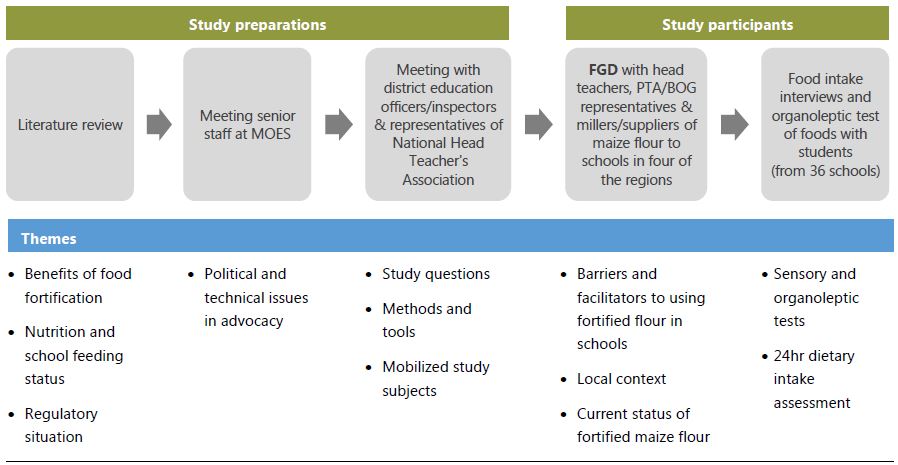
Selection of Participants
We randomly selected 36 of the 56 secondary schools that met our criteria in the four sub-regions to participate in our study. To be selected, schools had to have more than 700 students enrolled and a boarding section. Within each school, we randomly selected four students (without replacements) from registers from the S1, S2, S3, and S5 classes, ensuring roughly equal sex ratio representation from each. From the list of 16 students, eight were randomly selected to participate in the organoleptic tests and eight in the dietary intake assessment. Figure 2 presents a flowchart of participant selection and sample size. Two-hundred-and-sixteen students participated in the organoleptic assessment; 216 students participated in the 24-hour recall survey for maize-based foods; and another 193 students participated in the 7-day survey of essential food groups.
Qualitative Methods
Figure 2: Flowchart of Study Participants’ Selection
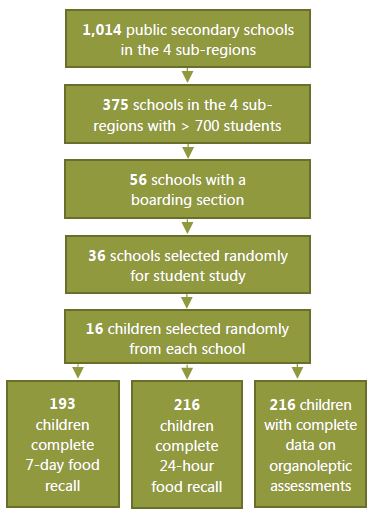
We conducted 10 FGDs using a semi-structured interview guide. Before the discussions, participants attended sub-regional sensitization meetings about the study and the national fortification policy. We planned to hold two or three FGDs in each of the sub-regions (one with head teachers, board of governors/administrators, and millers/suppliers of milled maize flour) for a total of 8–12 FGDs. However, because of the enthusiasm during the sensitization meetings, many more people wanted to participate in the discussions. So we held additional FGDs to keep groups small and to maintain participant’s goodwill for future activities, ultimately conducting four FGDs with head teachers, four with millers, and two with administrators and board members in each sub-region.
Qualitative Data Analysis
An external service transcribed all group discussions. The study team cross-checked transcriptions and audio files for accuracy. Group discussion transcripts were coded using four parent coding categories: 1) barriers and facilitators to production and use of fortified maize; 2) where maize flour is acquired; 3) factors that influence purchasing, and; 4) factors that affect the general price of maize or flour. Coding was conducted by two SPRING team members using Dedoose, a web application for analyzing qualitative and mixed-methods research, and thematic analysis was performed using Excel-based coding matrices. All coding and analysis was reviewed by the two team members and discrepancies were resolved by consensus. Direct quotes from participants are included to illustrate key issues and themes from FDGs.
Quantitative Methods
We conducted a 24-hour food recall survey for maize-based foods with 216 students. We also conducted a 7-day food intake survey with 193 students, asking about consumption of essential food groups. The interviewer gave prompts to help respondents remember eating and drinking episodes by time and to help respondents estimate portion sizes. Respondents reported how many times they had eaten foods from nine different food groups.
We conducted the organoleptic assessment with 216 students who were not involved in the food intake surveys. The school cook prepared 100 gram samples of maize-based porridge and posho with fortified and unfortified maize flour. The fortified foods were prepared with the government-approved blend of vitamins and minerals. Participants were given samples in odor-free disposable cups marked with 3-digit random codes. Participants rated general appearance, color, taste, aroma, mouthfeel, aftertaste, thickness/texture, and overall acceptability of each sample using a 9-point scale, with higher scores representing higher acceptability.
Quantitative Analysis
All quantitative data were entered and analyzed using SPSS version 20. We assessed sensory measures of general acceptability for taste, color, flavor, aftertaste, and appearance using a hedonic scale from 1 to 9. Paired t-tests were used to compare the mean scores on the four products (fortified and unfortified posho and porridge). We assessed differences in scores by sex and by region. Where comparisons were made, significant differences were determined at the 95 percent confidence level (p < 0.05).
For the food intake data, average food diversity scores were based on the self-reported number of food groups (maximum of nine) consumed in the previous seven days. We used the HarvestPlus food composition database for Uganda to calculate the nutritional value (i.e., vitamin A, zinc, iron, and folate) of the food consumed. We also collected the study schools’ recipes for posho and porridge. The amount of posho and porridge a student reported consuming in one day was used to extrapolate the possible daily intake of key nutrients if the maize flour was fortified using the Uganda food fortification standards.
Ethical Considerations
To protect participants’ anonymity, no names, communities, or schools are identified in this paper. Participants were informed that participation in the assessment was voluntary and all information collected would be confidential, aggregated, and used for intended purposes only. All who accepted gave informed consent. Refusals were verifiable by using the “no” consent forms. All hard copies were stored securely, with access granted to the research team members only. These copies will be destroyed within one year of the study’s completion.
Obtaining Consent for School Children under 18 Years Old
The average age of school children in the study was 17 years old. The researchers aimed to protect their rights by: a) obtaining signed consent from head teachers to conduct the study under their observation; b) working with the school cook to prepare the sample foods used in the study; c) minimizing the amount of food served for the tests (about 10 grams per child); d) soliciting a district education officer (or his/her representative) and MOES representative to observe the study, and; e) keeping the food intake questionnaire succinct. We also obtained permission to conduct the study from senior MOES personnel.
Results
From this study, we identified five major themes to consider when procuring fortified foods (Table 1).
| Major themes | Sub-theme |
|---|---|
| Awareness |
|
| Acceptance of the fortified product |
|
| Additional value of fortification |
|
| Cost/price considerations |
|
| Access to fortified product |
|
Theme 1: Awareness of benefits of fortification and policies on fortification
FGD participants had limited understanding of the importance of fortification until the study team’s sensitization meetings. Respondents believed that parents, teachers, and the community were also not aware of the benefits of food fortification. Some respondents had seen media campaigns on fortified foods, but they did not find the campaign interesting.
I think most of the schools we have in Uganda don’t feed children on fortified maize flour. The reason is simple, most head teachers and board members in the schools are not informed about fortification and its importance on health and performance. This kind of research may have been conducted here in Uganda but the results were not shared with us or the public. Things will be different when more teachers start getting the message.
-Head teacher FGD, Greater Kampala
The Government of Uganda’s School Feeding and Nutrition Intervention Guidelines have been in existence since 2013, but few head teachers indicated that they had seen it. Respondents explained there has been little or no government sensitization to the policy. Most maize millers in the FGDs did not know of the fortification legislation, which mandates fortification for producers with daily operational capacity of 20 metric tons or more.
Before requiring fortified maize flour at all boarding schools, or disseminating the current school feeding laws, respondents mentioned the need to sensitize teachers, parents, children, and millers to the importance of food fortification. Some suggested that sensitization efforts would be more effective if they focused on promoting the academic and health benefits associated with eating fortified foods.
Feeding in schools hasn’t been so much an issue of serious dialogue. We feed students food to keep them going. Our major concerns, sorry to say, is whether they are performing well; are we getting the grades? What students eat has not been so much an issue even at board level, unless it is about its procurement.
-Board member FGD, Acholi
There are potential misconceptions and community resistance to fortified foods. Respondents felt some people would confuse fortification with adding “drugs” or “chemicals” to the flour. For this reason, parents and teachers may reject the idea of fortified flour.
Respondents indicated that sensitization should start with district leaders and politicians, then be expanded to established platforms such as community meetings and radio programs. Teachers should also be trained to educate parents and children.
Theme 2: Acceptability of foods made with fortified maize flour by students, community/parents, and teachers
There was consensus among respondents that ascertaining acceptability with stakeholders is important. While millers said they would fortify in compliance with government regulations, they worried that if the community did not like fortified foods, they would blame millers’ machines for “adding metals to the flour.”
I have heard people saying that our machines are adding metals into the flour. That is just propaganda from people who are promoting imported milling equipment from China. If we fortify and the taste is different people will start to think our machines are the ones adding the metals in the flour. I don’t like this whole idea. We must do more research and make sure people don’t mind those [fortified] foods.
-Miller FGD, Busoga
There was also concern that if parents don’t accept the fortified flour they will influence the school management not to support it.
When parents don’t like the flour, it is because they have heard from their children it is not good or they tasted it, or have heard others say something bad about it. They will make the board use all kind of excuses, including price. We must make sure this product is available even in our local markets so that they taste it themselves and see the difference if there is any.
-Board FGD, West Nile
School head teachers felt students often don't like change, so if fortifying the flour changes the taste or color, students will not accept it. But some head teachers felt that sensitizing students could prepare them for the change and encourage them to accept the fortified flour.
We have parents in the refugee camps where they get this fortified foods from World Food Programme. They are used to it. There also parents and children near those communities and they have eaten it. We should have them give testimony of how this food is.
-Head teacher FGD, West Nile
The students’ perception about the food is key. They want to eat what they have been eating before; if we bring change we should know it may backfire on school’s administration. They will look at the color and the taste the food. If it is different then we have to do good sensitization of the students before the food comes and when we are feeding them.
-Head teacher FGD, Acholi
Students can go on strike because of the change in taste of the food. The food should be the same in taste and color as the one they have been used to. One more thing. I think even the grade of flour should be the same. We should start with the grade 2 flour.
-Board FGD, Busoga
Figure 3. Mean Differences of Scores for Sensory Attributes for Unfortified versus Fortified Porridge
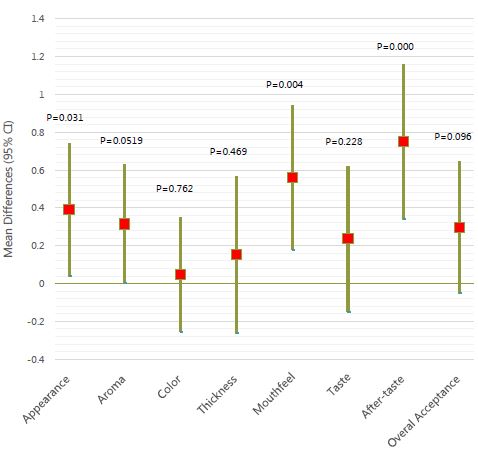
Data (presented in Figures 3 and 4) from student organoleptic tests indicate that adolescent school children found both posho and porridge prepared with fortified and unfortified maize flour acceptable. However, they were able to differentiate the fortified versus unfortified porridge by mouthfeel and aftertaste, and could distinguish fortified versus unfortified posho by aroma, thickness, mouthfeel, taste, and aftertaste.
The issue of aftertaste in the products made of fortified maize flour should be of concern to millers and school administrators, as posho average aftertaste score was 5.2 for unfortified and 4.3 for fortified, as indicated in Figure 4. One of the schools that bought the fortified flour returned it after four months, complaining of an aftertaste in products made from the flour.
Figure 4. Mean Differences of Scores for Sensory Attributes for Unfortified versus Fortified Posho
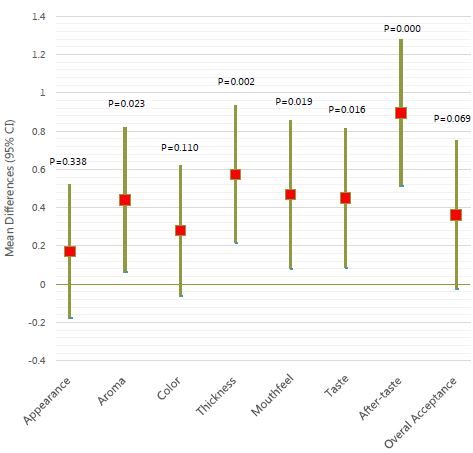
A few respondents suggested that a pilot in a few schools could test all aspects of handling fortified foods, including storage conditions, shelf-life, cook-ability, and acceptability by children. The results of the pilot could be used to advocate for fortified foods. Some respondents suggested that informing people that they already consumed fortified foods (e.g., oil, salt, wheat products) could help build trust for fortified maize flour. One informant suggested that passing a law mandating flour fortification while keeping the price stable would be enough; there would be no need for sensitization because if all maize flour were fortified, the element of decision making between a fortified versus an unfortified product would be moot (although there is a long way to go before reaching this point).
A few respondents mentioned using "student ambassadors" who have tasted and accept fortified flour to help convince other students to accept it.
Theme 3: Added nutritional value of fortification
Our dietary intake survey found that children derived over 50 percent of their energy needs from maize flour foods provided in school. However, current school maize-based meals are poor in micronutrients—especially iron; girls met 28 percent of their iron recommended daily allowance (RDA) and boys met 48 percent of the iron RDA from maize-based foods. Girls’ intake of micronutrients was lower because they consumed smaller quantities but also because their daily iron requirements are higher than those of boys (see Figure 5).
Figure 5. Additional Value of Fortification on RDA of Key Nutrients, by Sex
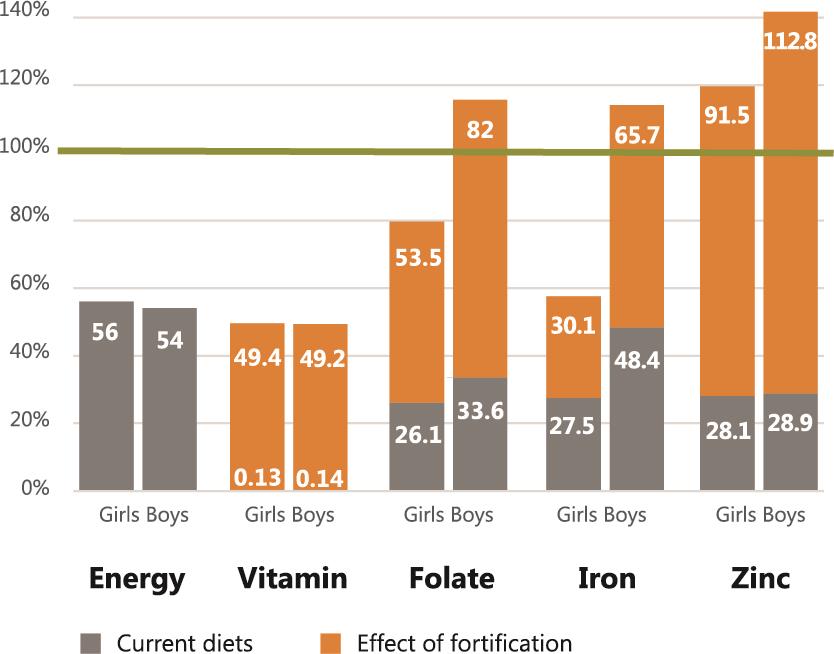
If school children relied entirely on the unfortified maize products served in school, they would not meet all of their iron needs. If the maize used in schools were fortified, students’ daily nutrient intake would increase between 45 to 100 percent. Fortification would cause a significant increase in the intake of vitamin A, iron, zinc, and folate. Boys would, on average, attain daily needs for folate, iron, and zinc, while girls would attain their needs for only zinc. This is, however, only if the main source of these nutrients was from maize flour meals. Girls would need to consume other iron-rich foods to meet their RDA.
Figure 6. Frequency of Serving of Food Groups by Schools and Consumption by Students
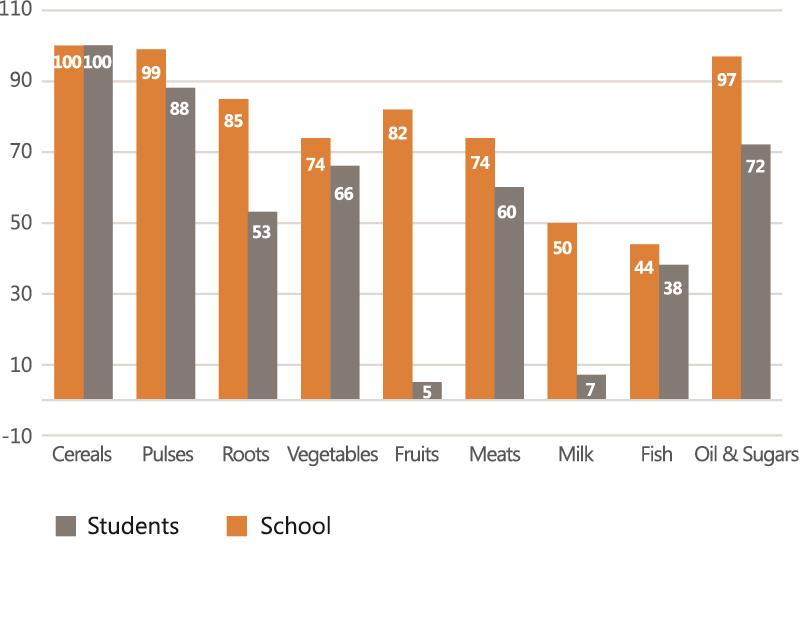
Our data show that in the seven days prior to the food consumption survey, schools served a variety of approximately four food groups (see Figure 6). We found all schools surveyed had served maize flour meals in the past seven days.
Pulses, specifically beans, were the next-most-common food ingredient, consumed in 88 percent of the surveyed schools. Sixty-six percent of schools indicated they had served a vegetable at least one of the seven days prior to the survey, the main vegetable being cabbage. Only 5 and 7 percent had served fruits and milk products, respectively. However, school children were able to access other foods that increased their dietary diversity from four to seven food groups per week. Some head teachers in northern and eastern Uganda reported that they encouraged students to bring groundnut or sesame paste (Odii) from home to enrich foods served from school.
We noticed many were bringing Odii from home or buying it locally. Some students even sell it. Now we encourage them to bring it [groundnut/sesame paste] or have their parents bring for them during visiting days. It improves taste, is healthy, and makes them strong. Even if it is a spoon in their beans, it is better. We are discouraging them to bring Blue Band [margarine]. Others bring their other concoctions of groundnuts, soya, or omena [silver fish] and even herbs as supplements.
-Head teacher FGD, Acholi
Theme 4: Cost and price considerations of food fortification
Head teachers reported that school feeding costs about 40 percent of the school budget (ranging from 19 to 80 percent of school budgets in 2016). Most respondents indicated the food is one budget item that parents do not support increasing. Schools try to keep the budget constrained as much as possible by: a) negotiating with suppliers; b) buying a cheaper grade of maize flour (grade 1.5 or higher); c) buying maize grain when it is cheaper, and; d) sourcing maize from parents and milling it themselves.
Several respondents mentioned the importance of price in determining which type of maize or posho to purchase. The higher grade the flour, the more components of the maize, germ, bran, and endosperm are retained in milling, and the lower the price. Most FGD participants suggested that schools in poor, rural areas use grade 1.5, 2, or 3 because they are cheaper than grade 1. It was indicated that some students prefer lower grade flour because it is more filling and tastes better. Respondents claim that because grade 1 (which is whiter in color, smaller particle size, and 60–70 percent extraction rate) is used in most homes, children will also demand for it in schools.
Respondents feared the school feeding costs would increase with a switch to fortified flour because of the associated equipment and supplies and additional electricity and processing methods. The perception was that these costs would be too high for most millers (or schools with milling equipment). The other concern was that using fortified flour in schools might cause demand to outweigh supply, which would further increase the price.
The majority of respondents said that using fortified flour in schools might mean that parents pay higher fees. Parents typically have low socioeconomic status so even a small increase in fees negatively affects and causes them to disapprove of the change. Head teachers worried that parents might move their children to schools that don't use fortified flour and have lower fees.
The fee structure is determined by the school board, yes? But normally the fees are paid by the parents; the category of parents that we are talking about is those that are always mindful about the amount of money they pay to schools. Now if the prices are higher than what the current maize flour prices are, parents and the board will start questioning; “why are we going for this more priced flour and not the lower priced one?” You know a fee change can bring conflicts in schools. So it goes back to us sensitizing our parents about the benefits of this fortified maize flour. We need to explain the advantages, because for us locally, food is food.
-Head teacher FDG, West Nile
Figure 7: Price per Kilo of Fortified and Unfortified Maize Flour by Company Name in Uganda, November 2017
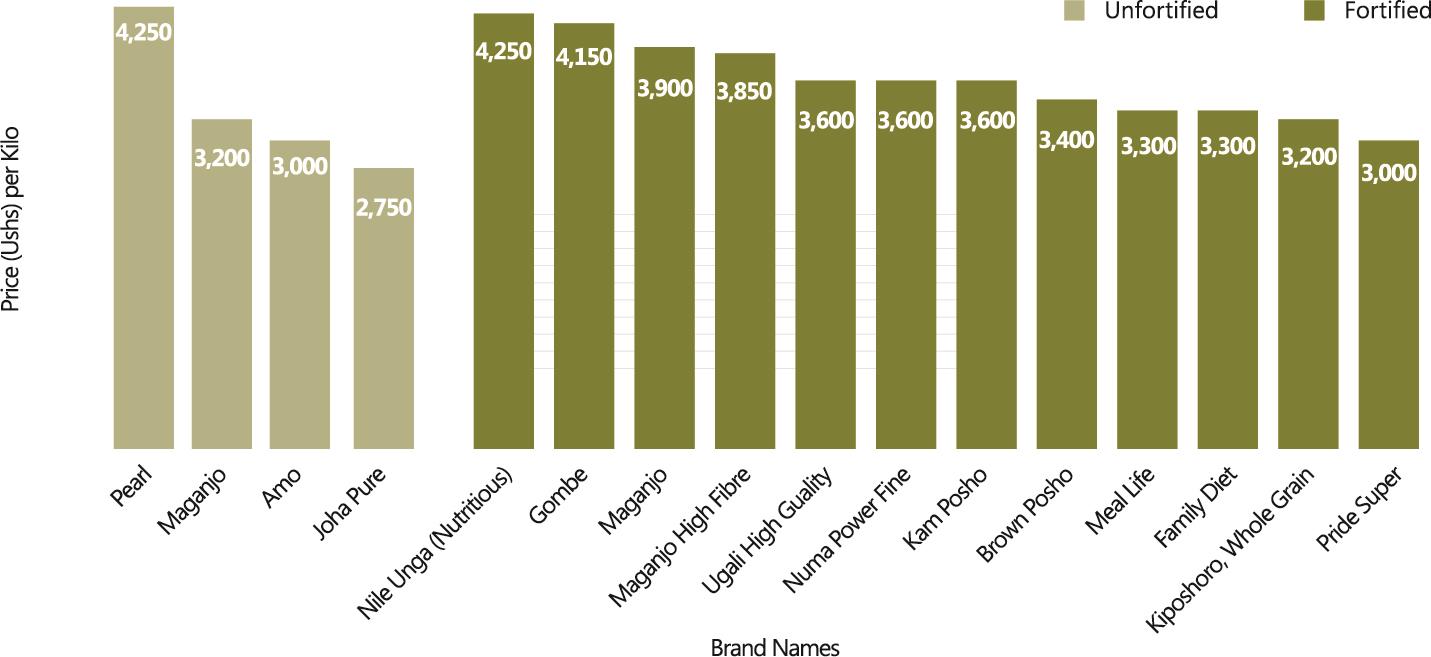
In fact, perceived prices of fortified maize flour exceeded actual market prices. School surveys indicated that schools paid on average 2,200 Ugandan shillings (UGX) per kilogram of (unfortified) maize flour (ranging between 1,600 to 3,000 UGX depending on the grade of flour and season) in 2016. We collected prices from four fortifying maize millers in Uganda and found that fortified maize flour costs between 1,800 and 3,000 UGX per kilogram. This variation was explained by quantities ordered, contract agreement, and availability of maize. Market [retail] prices (Figure 7) show that there was not a significant difference between the prices of fortified and unfortified flour.
Three of the four fortifying companies indicated they were willing to partner with schools and provide them with fortified flour at the same price, if schools would maintain their commitments.
We discussed with some schools that we were willing to supply them with fortified maize flours. They bought once but did not come back. We had complained that they were not keeping their commitment in paying on time. They also kept changing the amounts they wanted; they wanted to reduce the amounts. We think they got someone selling to them at a lower price. It is very difficult to compete with small millers; most don’t pay taxes, they do simple packaging and use local technologies as they have not invested in expensive machines.
-Miller FGD, West Nile
Millers also mentioned throughout that people and schools are not willing to pay more for higher-quality maize and fortification. Respondents stated that as long as there was cheaper unfortified maize, the market for fortified maize would be constrained.
Even when we have tried to use quality of flour as the basis for why schools should buy from us at slightly higher price, schools have still gone for the cheaper, poorer-quality maize. Most of that [maize] flour they buy is milled in very unhygienic environments. Those millers use poorer quality maize grain and are not subject to periodic quality monitoring we receive from UNBS. But school management doesn’t care as long as the flour is cheaper and students don’t complain.
-Miller FGD
Theme 5: Access to fortified maize flour by schools
Figure 8: Proportion of Fortified Maize Flour Procured, by Institution Type
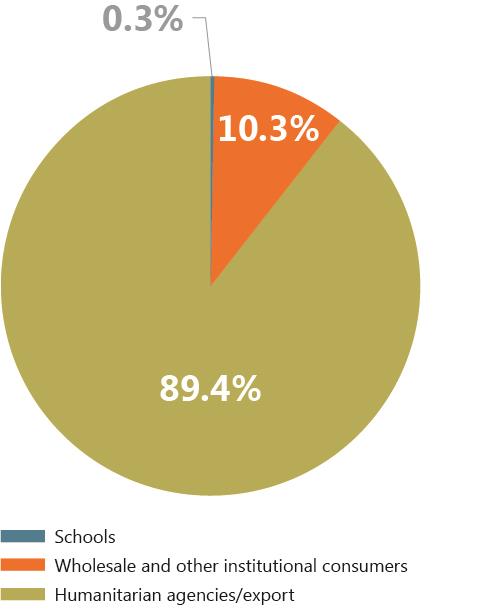
Our survey of maize millers indicated that of the 16,600MT fortified flour produced in 2016, only 0.3 percent was sold to institutions (see Figure 8).
Respondents indicated that most schools procured maize flour through a process defined by the government in the Public Procurement and Disposal Act, in which schools advertise their needs, suppliers apply and quote a price, and schools select a product or negotiate terms and prices. Respondents indicated that local context dictates informal agreements between the supplier and the school management. Parents in rural areas often contribute food (mainly maize grain and beans) in-kind for their children to eat in school. Schools then bring the maize to a local miller or mill on-site. Miller FDG respondents thought that bigger millers might not be receptive to this kind of informal agreement.
Respondents mentioned problems with maize flour spoiling due to lack of proper storage or because the maize was not prepared properly. Some schools make one order per term but have the commodity delivered two or three times in smaller quantities due to lack of storage space and potential for spoilage. Two of the fortifying millers indicated that flour spoiled in storage by schools was returned.
We sold about 20MT to a school. We informed them the flour was fortified and the shelf life was 6 month. What happened is that they did not use all the flour before the term ended. When the [new] term started they said it had spoiled; it developed an aftertaste after four months, and they wanted us to replace it. Actually it is because they stored it in poor conditions; so we could not do that [replace it]. They need to have good storage. The school never came back to buy more. We need to accompany the selling of fortified foods with education on use and storage; and maybe support them.
-Miller FGD
Millers also had trouble with schools’ delays in payment and need to purchase maize on loan. Some schools receive Universal Secondary Education (USE) funds from MOES, and delays in this funding affect millers’ payment. Parents often pay school fees on installment, so sometimes schools have to purchase maize on loan and pay later, which may be less agreeable for large-scale millers.
Schools are not great to work with; they involve too much bureaucracy and sometimes can't pay on time. Especially the USE schools always delay paying because government delays sending the USE money to schools, which affects supplying the schools with maize flour. The best idea would be for the smaller millers to be supported to do fortification, so that schools don’t have to rely on the bigger millers from outside their localities. Schools that have their own mill can also be supported to access the premixes for fortification or you have them available in the markets for purchase or [initially] provided to schools so they can fortify the flour they mill.
-Miller FGD, Busoga
Since only a few millers produce fortified flour, respondents were fearful that multiple orders during the start of a school term would lead to delays and price inflation. However, a few schools procured flour from large maize millers during the study recall period of July 2016 to July 2017. Millers reported they were interested in supplying to schools because there was lack of demand for fortified flour in local markets and they could guarantee a fixed price throughout the school term.
Discussion
The boarding schools we surveyed give adolescent students meals that are limited in essential food groups such as fruits, milk, vegetables, and meat. Cereals, specifically maize-based, are the main ingredient in meals and provide most of the energy and nutrients to students. Although maize flour products alone cannot meet adolescents’ recommended micronutrient needs, in situations of low dietary diversity and nutrient quality, fortified flour can be a cost-effective source of nutrients including folate, iron, zinc, and vitamin A. We inferred that if adolescents ate the same quantities of fortified maize-based products, boys would meet their recommended daily intakes for most nutrients. However, girls would be unlikely to meet their needs for vitamin A, iron, and folate because they eat smaller amounts of foods and have higher nutritional requirements. Studies that have done similar simulations also found that fortified flour would contribute highly to the RDI (Onwuamaeze, Hedwig, and Dorothy 2017).
A food’s sensory characteristics can influence consumption and nutrient intake. Aftertaste is a possible reason for schools to avoid fortified flours. We identified a school that had bought fortified flour and, complaining of an aftertaste, returned it to the miller. Uganda standards recommend the use of NaFeEDTA as the fortificant compound for iron, which is better absorbed and causes fewer organoleptic changes in cereal products (Bothwell and MacPhail 2004). Fortified foods are likely to have metallic taste if other fortificant compounds are used. Odor and color do not seem to be a factor in product preference. The adolescents we surveyed accepted products made with fortified and unfortified flours equally, and did not consider the differences in aftertaste a deterrent. We suggest further study on whether aftertaste is related to the shelf-life of the fortified product. We found one school that did not complain of fortified flour when it was freshly made but did complain of an aftertaste in the same flour after four months.
We found the price difference between fortified flour and unfortified flour is not significant. The incremental cost of purchasing fortified foods is small, but school administrators’ fears of the about cost and cost fluctuations are high. They will need to be educated about the actual cost of fortified maize flour. Overall, there is a lack of school administrator and parent awareness about not only the price of fortified flour, but of its benefits. A strong communications program could changes these perceptions, and the government could emphasize fortified flour as the direction for all schools to take in school feeding programs. Raising awareness and conducting sensitization are keys to advancing fortified flour procurement in schools.
Conclusion and Recommendations
Policy Implications
Without a requirement that all millers in Uganda (irrespective of their production level) fortify maize flour, or legislation that schools must use fortified maize flour for making meals, head teachers will find reasons why procuring fortified flour is not workable within their contexts. Substituting fortified flour is a deviation from current practices and school administrators worry about parental concern, increased cost, and student acceptance of the new food.
Fortification regulations in Uganda need to be reviewed. All packaged flour should be fortified and labeled according to national guidelines. Furthermore, all government-managed institutions in Uganda (military, prisons, hospitals, schools), consumers of a large proportion of flour in the country, should be required to use fortified flour.
Because schools face challenges finding funding for flour through the traditional procurement process, the government should pilot a voucher system and stop late delivery of USE funds to schools. Because the added cost of fortified versus unfortified flour is little or none, this system would be a low-cost solution to the perceived financial burden of purchasing fortified flour in schools and would ensure that cost would not be a barrier.
Programmatic Implications
Sensitization to the benefits of fortified foods on adolescents’ micronutrient status should be conducted with senior MOES personnel, school management, and parent school committees. Stakeholders need to know that fortified food, iron specifically, can help control anemia among students. SPRING has developed a 7-minute advocacy video to promote the use fortified flour for school feeding. It could be shown at meetings with head teachers and teachers, and at the head teacher district meetings held each term.
Meetings for school heads and administrators and fortified maize flour millers need to be held, especially in the north and Greater Kampala, where there are companies that sell fortified maize flour at the same price as unfortified flour. These could be one-day events at which millers could demonstrate their products, government departments could explain the importance of using fortified flours, and head teachers could ask questions.
We found that more schools are doing their own milling, which could deter implementation of a regulation that requires institutions to use only fortified flours. One option is for schools that mill their own flour to learn about small- and medium-scale fortification technology options. Schools in the same district (or sub-region) could come together for bulk buying of fortificants and negotiate sustainable prices and reduction of transport costs. The government or development partners could pilot and cost such a model, which provides subsidized fortificants and equipment for a specified length of time. Such a pilot could be used to study the effects of fortification on children’s nutritional status.
Since students cannot receive their daily micronutrient intake from fortified maize flour alone, schools should provide broader nutrition education programs. Schools should increase access to other food groups, including proteins, fruits, and vegetables, and encourage students to diversify their diets.
Research Implications
Though a majority of school children noticed the aftertaste of products made from fortified maize flour, there was essentially no difference in acceptability between the foods with fortified and unfortified maize flour. However, aftertaste could be a deterrent to use of fortified flour by students and the general public. Further research is needed to see if aftertaste is affected by shelf-life, storage conditions, or other factors, and corrective interventions should follow.
We need additional data on the impact of fortified maize flour on Ugandan school children. For example, dietary intake studies for school children using 24-hour recall of all foods consumed should be conducted. The assessment of biomarkers after consumption of fortified flours would also be interesting to examine. Where possible, such data should be linked to cognitive performance indicators. Costing data on alternatives to food fortification can be collected to justify the cost-effectiveness of fortification. Even without additional research, however, our study suggests that fortified maize flour can bridge the micronutrient gap for adolescent boys and improve adolescent girls’ consumption of vitamin A, folate, iron, and zinc. Understanding how important adequate adolescent nutrition is for optimal growth and cognitive development, and how this impacts the productivity of present and future generations, the provision of fortified food at school to ensure Ugandan children have access to at least some of these necessary micronutrients must be prioritized.
References
African Union Commission [AUC], and World Food Programme [WFP]. 2014. The Cost of Hunger in Uganda: Implications on National Development and Prosperity. https://www.wfp.org/content/cost-hunger-uganda.
Alderman, Harold. 2007. “Improving Nutrition through Community Growth Promotion: Longitudinal Study of the Nutrition and Early Child Development Program in Uganda.” World Development 35, no. 8: 1376–89. https://doi.org/10.1016/j.worlddev.2007.04.003.
Andang’o, Pauline E. A., Saskia J. M. Osendarp, Rosemary Ayah, Clive E. West, David L. Mwaniki, Corine A. De Wolf, Rob Kraaijenhagen, Frans J. Kok, and Hans Verhoef. 2007. “Efficacy of Iron-Fortified Whole Maize Flour on Iron Status of Schoolchildren in Kenya: A Randomised Controlled Trial.” Lancet (London, England) 369, no. 9575: 1799–1806. https://doi.org/10.1016/S0140-6736(07)60817-4.
Barugahara, E. I., J. Kikafunda, and W. M. Gakenia. 2013. “Prevalence and Risk Factors of Nutritional Anaemia among Female School Children in Masindi District, Western Uganda.” African Journal of Food, Agriculture, Nutrition and Development 13, no. 3. https://www.ajol.info/index.php/ajfand/article/view/90598.
Bellisle, France. 2004. “Effects of Diet on Behaviour and Cognition in Children.” British Journal of Nutrition 92, no. S2: S227–32. https://doi.org/10.1079/BJN20041171.
Best, Cora, Nicole Neufingerl, Joy Miller Del Rosso, Catherine Transler, Tina van den Briel, and Saskia Osendarp. 2011. “Can Multi-Micronutrient Food Fortification Improve the Micronutrient Status, Growth, Health, and Cognition of Schoolchildren? A Systematic Review.” Nutrition Reviews 69, no. 4: 186–204. https://doi.org/10.1111/j.1753-4887.2011.00378.x.
Bothwell, Thomas H., and A. Patrick MacPhail. 2004. “The Potential Role of NaFeEDTA as an Iron Fortificant.” International Journal for Vitamin and Nutrition Research. Internationale Zeitschrift Fur Vitamin- Und Ernahrungsforschung. Journal International De Vitaminologie Et De Nutrition 74, no. 6: 421–34. https://doi.org/10.1024/0300-9831.74.6.421.
Brown, Erika, and Mark Kern. 2015. “Prevalence and Associated Factors of Malnutrition Among Primary School Students in the Rakai District of Uganda.” The FASEB Journal 29, no. 1 Supplement: 579.9.
Chen, Chun-Ming, Yu-Ying Wang, and Su-Ying Chang. 2010. “Effect of In-Home Fortification of Complementary Feeding on Intellectual Development of Chinese Children.” Biomedical and Environmental Sciences: BES 23, no. 2: 83–91. https://doi.org/10.1016/S0895-3988(10)60036-0.
Finkelstein, Julia L., Saurabh Mehta, Shobha A. Udipi, Padmini S. Ghugre, Sarah V. Luna, Michael J. Wenger, Laura E. Murray-Kolb, Eric M. Przybyszewski, and Jere D. Haas. 2015. “A Randomized Trial of Iron-Biofortified Pearl Millet in School Children in India.” The Journal of Nutrition 145, no. 7: 1576–81. https://doi.org/10.3945/jn.114.208009.
GAIN (Global Alliance for Improved Nutrition). 2015. The Fortification Assessment Coverage Tool (FACT) to assess the coverage and consumption of fortified vegetable oil, wheat flour, maize flour and salt. Kampala: Uganda Ministry of Health.
Goyle, A., and S. Prakash. 2011. “Effect of Supplementation of Micronutrient Fortified Biscuits on Serum Total Proteins and Vitamin A Levels of Adolescent Girls (10-16 Years) of Jaipur City, India.” Nepal Medical College Journal: NMCJ 13, no. 4: 233–37.
Ivanovic, D., M. Vásquez, M. Marambio, D. Ballester, I. Zacarías, and M. Aguayo. 1991. “Nutrition and Education. II. Educational Achievement and Nutrient Intake of Chilean Elementary and High School Graduates.” Archivos Latinoamericanos De Nutricion 41, no. 4: 499–515.
Jomaa, Lamis H., Elaine McDonnell, and Claudia Probart. 2011. “School Feeding Programs in Developing Countries: Impacts on Children’s Health and Educational Outcomes.” Nutrition Reviews 69, no. 2: 83–98. https://doi.org/10.1111/j.1753-4887.2010.00369.x.
Kaijuka, Emmanuel M., Edward Z.A. Kaija, Anne R. Cross, and Edilberto Loaiza. 1989. “Uganda DHS, 1988-89 – Final Report (English).” Accessed December 6, 2017. https://dhsprogram.com/publications/publication-fr41-dhs-final-reports.cfm
Lwanga, Francis, Rhoda K. Wanyenze, Joseph KB Matovu, Teddy Chimulwa, and Christopher G. Orach. 2015. “Nutritional Status of HIV-Infected Adolescents Enrolled into an HIV-Care Program in Urban and Rural Uganda: A Cross-Sectional Study.” World Journal of Nutrition and Health, World Journal of Nutrition and Health 3, no. 2: 35–40. https://doi.org/10.12691/jnh-3-2-2.
Miglioranza, Lúcia H. S., José Wander Breganó, Isaias Dichi, Tiemi Matsuo, Jane Bandeira Dichi, and Décio Sabbatini Barbosa. 2009. “Effectiveness of Fortification of Corn Flour-Derived Products with Hydrogen-Reduced Elemental Iron on Iron-Deficiency Anaemia in Children and Adolescents in Southern Brazil.” Public Health Nutrition 12, no. 2: 244–48. https://doi.org/10.1017/S1368980008003704.
Mugabi, Albert. 2012. “Nutritional Status and Food Habits of Adolescents in Public and Private Boarding Secondary Schools in Hoima District.” Kampala, Uganda: Makerere University.
Onwuamaeze, Nwatarali Philomena, Acham Hedwig, and Nakimbugwe Dorothy. 2017. “Acceptability, Nutritional Quality and Contribution of Vegetable-Enriched Products to Nutrient and Energy Requirements of School Children Aged 5 to 13 Years.” Food and Nutrition Sciences 08, no. 02: 242. https://doi.org/10.4236/fns.2017.82016.
Pollitt, E. 1997. “Iron Deficiency and Educational Deficiency.” Nutrition Reviews 55, no. 4: 133–41.
Popkin, Barry M., and Marisol Lim-Ybanez. 1982. “Nutrition and School Achievement.” Social Science & Medicine 16, no. 1: 53–61. https://doi.org/10.1016/0277-9536(82)90423-3.
Seal, Andrew, Emmanuel Kafwembe, Ismail A. R. Kassim, Mei Hong, Annie Wesley, John Wood, Fathia Abdalla, and Tina van den Briel. 2008. “Maize Meal Fortification Is Associated with Improved Vitamin A and Iron Status in Adolescents and Reduced Childhood Anaemia in a Food Aid-Dependent Refugee Population.” Public Health Nutrition 11, no. 7: 720–28. https://doi.org/10.1017/S1368980007001486.
Turyashemererwa, F. M., J. Kikafunda, R. Annan, and G. A. Tumuhimbise. 2013. “Dietary Patterns, Anthropometric Status, Prevalence and Risk Factors for Anaemia among School Children Aged 5-11 Years in Central Uganda.” Journal of Human Nutrition and Dietetics: The Official Journal of the British Dietetic Association 26 Suppl 1: 73–81. https://doi.org/10.1111/jhn.12069.
World Food Programme. 2013. “2013 - State of School Feeding Worldwide | WFP | United Nations World Food Programme - Fighting Hunger Worldwide.” Accessed December 6, 2017. https://www.wfp.org/content/state-school-feeding-worldwide-2013.
World Health Organization. 2018. World Health organization Guideline: implementing effective actions for improving adolescent nutrition. Geneva: World Health Organization. Accessed May 7, 2018. http://apps.who.int/iris/bitstream/handle/10665/260297/9789241513708-eng.pdf;jsessionid=9EBE22E1D28DF4987D1B06A308AA0CA0?sequence=1
Uganda Bureau of Statistics [UBOS] and ICF International. 2012. “Uganda DHS, 2011 – Final Report (English).” Accessed December 6, 2017. https://dhsprogram.com/publications/publication-fr264-dhs-final-reports.cfm.

